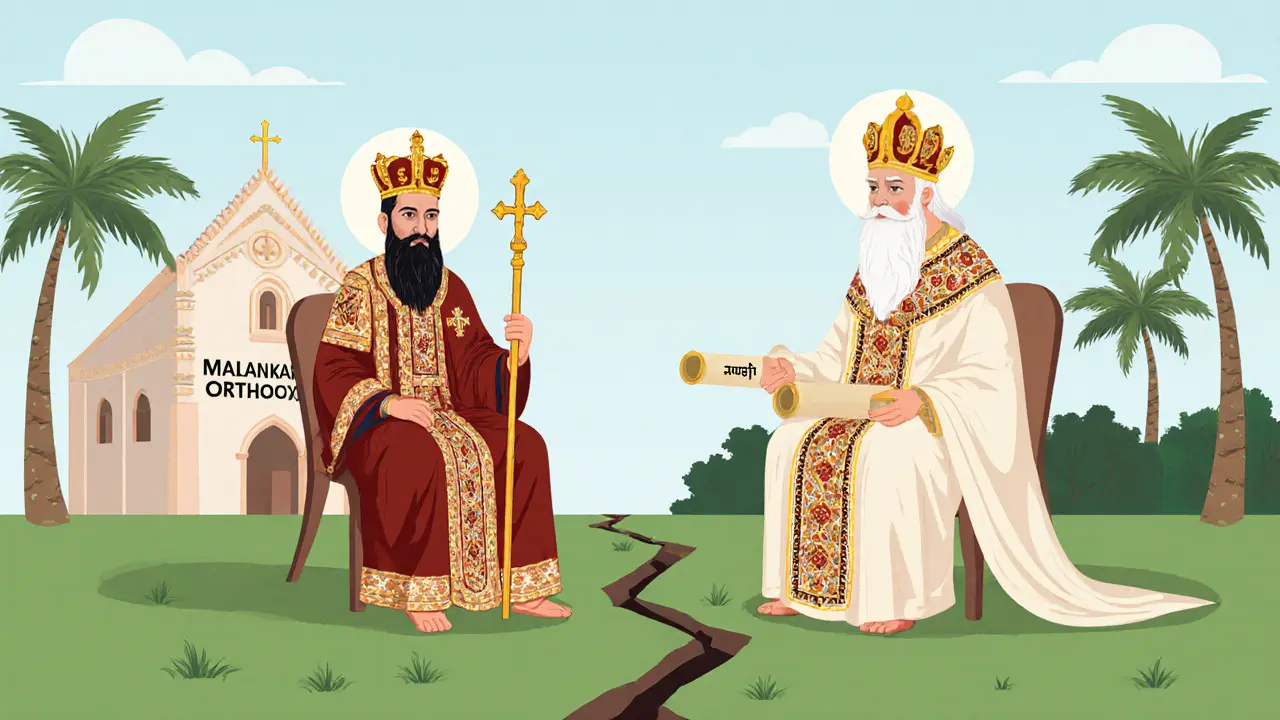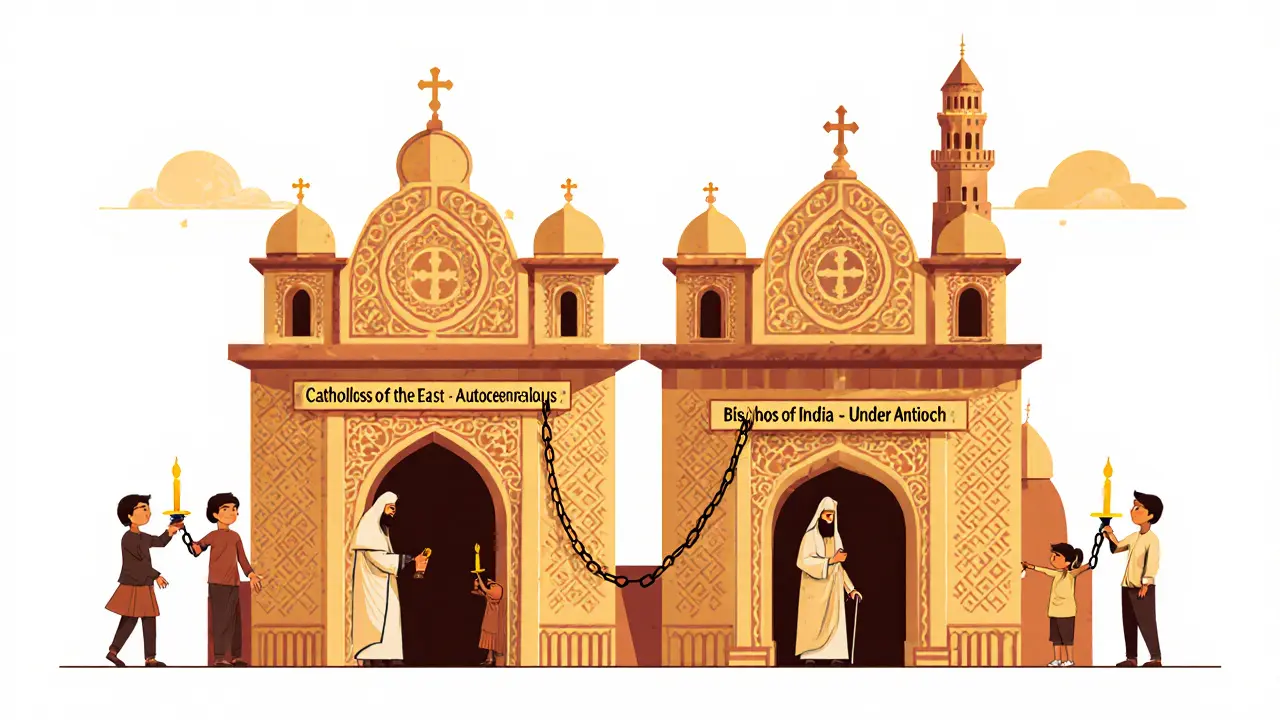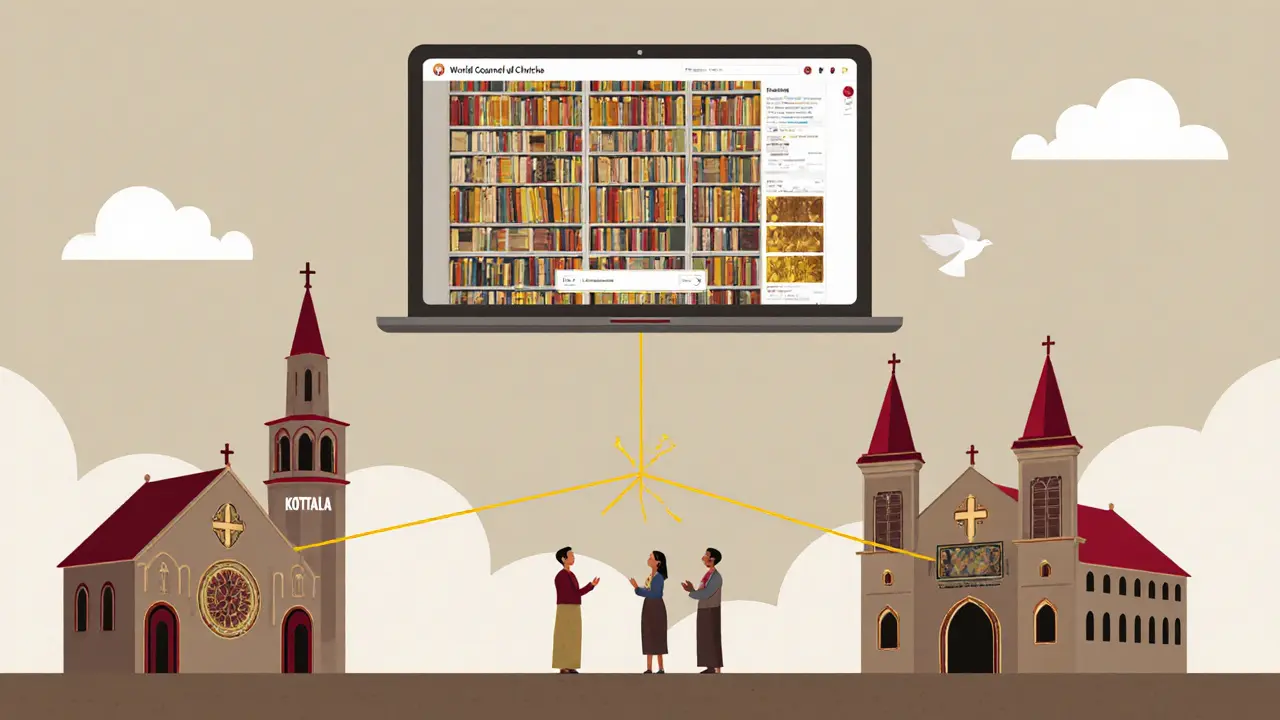
Who Is the Catholicos of India?
There isn’t just one Catholicos of India. There are two.
If you’ve heard the title and assumed it points to a single leader of India’s ancient Christian community, you’re not alone. But the reality is more complex. The term refers to two separate offices, each leading a different branch of the Saint Thomas Christian tradition - a community that traces its roots back to the apostle Thomas, who reportedly arrived in Kerala around 52 CE. These two Catholicoses don’t just share a name; they represent a century-old split in theology, governance, and identity.
The Two Catholicoses Explained
The first is the Catholicos of the East and Malankara Metropolitan, head of the Malankara Orthodox Syrian Church. He is currently Baselios Marthoma Mathews III, the 9th Catholicos of the East and 22nd Malankara Metropolitan. He leads an autocephalous church - meaning it answers to no one outside its own hierarchy. His seat is at Mar Eliyah Cathedral in Kottayam, Kerala. He consecrates bishops, presides over the Holy Synod, and manages all church affairs, including property, education, and finances.
The second is the Catholicos of India (also called Maphrian), head of the Jacobite Syrian Christian Church. He is currently Baselios Joseph, ordained on March 25, 2025, after the death of his predecessor. He sits at Mar Athanasius Cathedral in Puthencruz, Kerala. But here’s the key difference: he operates under the authority of the Patriarch of Antioch in Syria. He leads his own synod and manages parishes, but major decisions require approval from Antioch.
So one Catholicos is independent. The other is subordinate. Both hold the same ancient title. Both are based in Kerala. And both claim to preserve the true legacy of St. Thomas.
A History of Division
The split didn’t happen overnight. It began in 1912, when the Malankara Church, seeking greater autonomy, ordained its first Catholicos in India - Baselios Paulose I - without waiting for Antioch’s blessing. The Patriarch at the time excommunicated the Malankara Metropolitan, Dionysius Vattasseril, and declared the move illegal. But the Malankara Church stood firm. They believed their leadership had always been indigenous, rooted in centuries of local governance under Archdeacons before bishops from the Middle East arrived.
The real breaking point came in 1975. The Malankara Orthodox Catholicos, Augen I, publicly declared that the Patriarch of Antioch had no authority over the Malankara Church. In response, the Syriac Orthodox Synod excommunicated him. That’s when the two churches became permanently separate. The Malankara Orthodox Syrian Church became fully self-governing. The Jacobite Syrian Christian Church remained loyal to Antioch.
That division still shapes everything today - from who controls church buildings to which priests are ordained and how services are conducted. Even their liturgies, though nearly identical, are now administered by different authorities.

What Does the Catholicos Actually Do?
It’s easy to think of a Catholicos as just a bishop with a fancy title. But his role is far more administrative and symbolic.
In the Malankara Orthodox Syrian Church, the Catholicos of the East:
- Consecrates the Holy Mooron (the sacred chrism used in baptisms and ordinations)
- Ordains and installs bishops across India and the global diaspora
- Presides over the Holy Synod, which makes all doctrinal and legal decisions
- Acts as the final authority on church property disputes
- Represents the church in national and international ecumenical forums
In the Jacobite Syrian Christian Church, the Catholicos of India:
- Presides over the Holy Synod of the Jacobite Church
- Approves appointments of bishops within his jurisdiction
- Manages 32 dioceses across India
- Requires Patriarchal approval for major decisions, like opening new parishes or changing liturgical texts
Both men oversee massive institutions. The Malankara Orthodox Syrian Church runs 150 schools and 25 hospitals. The Jacobite Syrian Christian Church runs 120 schools and 20 hospitals. Together, they serve over 2.5 million people in India and another 1 million in the diaspora - from Toronto to Dubai.
Why Does This Matter to Ordinary Believers?
For most parishioners, the difference isn’t theological. The prayers are the same. The hymns are nearly identical. The saints are the same. But the administrative split affects daily life.
If you’re baptized in a Malankara Orthodox parish, your marriage records are kept by the Malankara Catholicos’s office. If you’re baptized in a Jacobite parish, they go to the Jacobite Catholicos’s office. If your church building is seized in a legal battle - and there have been dozens - the court will ask: Which Catholicos does this church follow?
On Reddit, a user from Toronto wrote: “My family has been Malankara Orthodox for five generations. When the Catholicos visits our parish, it feels like the Pope coming to a small town. Everyone shows up. It’s not just religion - it’s identity.”
Another user from Kochi, who belongs to the Jacobite Church, said: “We don’t see ourselves as rebels. We see ourselves as keeping the ancient Syriac tradition alive - the same one our ancestors brought from Antioch.”
The 2022 National Council of Churches survey found that 68% of Saint Thomas Christians believe the Catholicos institution is essential to preserving their unique heritage. But 22% said the existence of two Catholicoses is a painful division.

What’s Next for the Catholicos?
Both churches are looking ahead - not just to survive, but to expand.
The Malankara Orthodox Syrian Church is building a new Catholicate Centre in New York, set to open in 2026. The $25 million project will serve as a hub for the growing Indian Orthodox diaspora in North America. They’re also digitizing centuries-old manuscripts, including handwritten liturgical texts from the 16th century.
The Jacobite Syrian Christian Church is working on digitizing its own 500-year-old archives - a ₹50 crore ($6 million) project expected to finish by 2027. This isn’t just about preservation. It’s about proving continuity. They want to show the world that their lineage, even under Antioch’s authority, is as ancient and authentic as the other side’s.
Both churches still sit together in the World Council of Churches. They still pray for unity. But no reconciliation has stuck since 2017, when talks collapsed over the simple question: Who is the supreme head?
For now, the answer depends on which side of the divide you’re on.
Legal Recognition and Cultural Impact
The 1958 Supreme Court of India ruling in the Malankara Church Case was a turning point. The court recognized the Malankara Orthodox Syrian Church as an independent body with full control over its properties and administration. That decision gave legal weight to their claim of autocephaly.
Dr. V.C. Samuel, a theologian and former professor at the Orthodox Theological Seminary in Kottayam, wrote in 1977 that the Catholicate system was “an indigenous expression of apostolic succession that predates European ecclesiastical models in India by centuries.” That’s not just a theological claim - it’s a cultural one. The Catholicos isn’t just a bishop. He’s a symbol of Indian Christian autonomy.
Dr. Scaria Kaliancath, a canon lawyer, noted in 2021 that the Indian Catholicate represents “a unique fusion of Syriac ecclesiology with Indian cultural context,” influencing other Eastern churches across Asia. That’s rare. Few Christian traditions outside the West have developed their own independent leadership structures that still hold global recognition.
Today, the Catholicos of India - whichever one you follow - is more than a religious leader. He’s the living link to a 2,000-year-old faith that never left India. He’s the keeper of Syriac liturgy, the guardian of ancient traditions, and the head of one of the oldest continuous Christian communities in the world.
Trent Mercer
28 10 25 / 11:54 AMHonestly, this is the most overcomplicated church drama I've ever seen. Two guys with the same title, same liturgy, same saints... but one has to ask permission to breathe? The real mystery is why anyone still cares in 2025.
Kyle Waitkunas
28 10 25 / 21:16 PMThis isn't just a church split-it's a global occult power play!!! The Patriarch of Antioch? He's a puppet of the Vatican's shadow council!! They've been suppressing the true Syriac bloodline for centuries!! I've seen the encrypted manuscripts-THEY ERASED THE NAMES OF THE ORIGINAL 72 BISHOPS!! The Malankara Orthodox are the only ones who remember the REAL apostolic succession!! They're hiding the Holy Mooron's true origin in a secret vault beneath St. Thomas Cathedral!! I've got the photos-someone needs to leak this!!
vonley smith
28 10 25 / 21:24 PMI love how this post breaks it down so clearly. It's wild to think two communities can share the same roots but end up on such different paths. Honestly? It's a reminder that faith isn't just about doctrine-it's about belonging. Whether you're tied to Antioch or rooted in Kerala, you're still part of something ancient and beautiful. Just gotta respect the journey, y'know?
Melodye Drake
29 10 25 / 02:19 AMI mean, it's adorable that they both claim to preserve 'authentic' tradition while ignoring that the very concept of a 'Catholicos' was imported from Persia in the 5th century. The Malankara Orthodox think they're indigenous because they use Malayalam? Please. The Jacobites at least have the decency to acknowledge their Syriac lineage. The real tragedy? Both sides are so busy fighting over who's more 'authentic' they've forgotten the Gospel.
paul boland
29 10 25 / 06:52 AMINDIA'S OWN CHRISTIAN EMPIRE!!! 🇮🇳🔥 The Malankara Orthodox are the TRUE heirs of St. Thomas-no foreign patriarchs telling us how to run our churches! The Jacobites are just colonial relics clinging to Damascus like a bad tattoo. The 1958 Supreme Court ruling? That was India saying 'NO MORE' to foreign ecclesiastical imperialism!! 🇮🇳🙏 #MalankaraPride #AntiochIsOut
harrison houghton
30 10 25 / 04:58 AMThe real question isn't who's independent or subordinate. It's whether the soul of a community can survive when its identity is defined by legal documents and bureaucratic authority. The Catholicos isn't a bishop. He's a mirror. He reflects what each group believes about power, history, and divine right. The split isn't about theology-it's about the human need to be the one who holds the truth. And that? That's the oldest sin of all.
DINESH YADAV
31 10 25 / 03:59 AMThis is why India must control its own religious institutions. Foreign powers have no right to tell us how to run our churches. The Malankara Orthodox are the real Indian Christians. The Jacobites are traitors to our heritage. We don't need Syrian approval to worship. Our ancestors fought for this autonomy. The Supreme Court knew it. The people know it. Only the puppets in Puthencruz still bow to Antioch.
rachel terry
2 11 25 / 01:36 AMSo one Catholicos is free and the other is basically a regional manager for a Syrian corporation? That's wild. I mean, if you're gonna keep the title, at least commit to the whole thing. Or just call one of them 'Regional Bishop with a Fancy Hat' and be done with it
Susan Bari
2 11 25 / 17:55 PMThe fact that they both use the same liturgy but can't agree on who's in charge is the most beautiful thing about this
Sean Hawkins
3 11 25 / 00:55 AMIt's worth noting that the autocephaly of the Malankara Orthodox Syrian Church was formally recognized by the Ecumenical Patriarchate of Constantinople in 1930, which adds canonical weight to their claim. The Jacobite Syrian Church, while historically aligned with Antioch, operates under a conciliar model that still allows for internal autonomy-just not final doctrinal authority. The real tension isn't theological but jurisdictional. Both churches maintain valid apostolic succession, sacraments, and liturgical integrity. The division is administrative, not soteriological. This isn't a schism in the classical sense-it's a governance dispute with deep cultural roots.
Marlie Ledesma
3 11 25 / 20:47 PMIt's sad how something so beautiful-this ancient Christian tradition-got split over who gets to sign the paperwork. I hope one day they can just sit down, share a cup of tea, and remember they both sing the same hymns to the same God.
Daisy Family
5 11 25 / 17:16 PMso like… one guy is the boss and the other is like… his intern with a crown? 😅